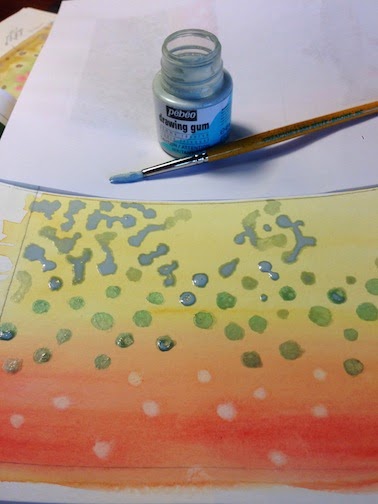I started on a new art book project, illustrating a handmade accordion book based on the celtic myth about the
Salmon of Knowledge. The story is short and perfect for several illustrations incorporating celtic designs. This will be my first finished project that encompasses drawing, painting and bookbinding.
First I printed out a draft of the text, and used it to put together a mock up of the book using card stock. This helped me decide on the subjects for the small illustrations, as well as the placement of the text blocks and illustrations on each page. It is much better to figure this all out ahead of time. In the end I found I would need eight pages, one for the title and seven more with text and illustration. Two additional end pages would be needed to attach the book covers.
With accordion folds the front and back of the pages can be seen, so I developed eight small sketches for the text side of the book and one long sketch to span the entire back of all eight text pages.
I tested different combinations of colors and media on the illustrations to find the right look. I worked with sepia, black, colored and metallic markers as well as a variety of watercolor pigments. The watercolors provide varied colors (fish at far right), while the metallic ink has a wonderful bright shine (fish at near right). For this book I will be using a combination of both watercolors and metallic ink.
I decided to use 90 lb multi-media paper instead of watercolor paper for the book pages, since it will stand up to repeated folding better than watercolor paper. To have a single long piece of paper for the text block, I would need a 35" long piece of paper. I purchased a
roll of Cason XL paper. I cut a 5" strip from the roll and trimmed it to the desired 35" length. Then I folded the long strip into 10 3.5" x 5" pages and pressed the accordion flat. This was the first time I had used rolled paper and I didn't anticipate how resistant to being uncurled the paper would be. Lesson learned: carefully uncurl the paper first!
I transferred the illustrations to the paper, and then carefully inked and painted. I worked on the small illustrations first, then on the large illustration that spans the reverse side of the paper. My original plan was to print the text directly on the paper, but because of the odd paper size (5" by 35") my printer would not cooperate. After fighting with it for several hours I decided to finish this book and work on the printer later. For this book I printed the text on velum, cut it to size and glued each section of text to the pages. The text block was now finished and ready for the covers to be attached.
I selected a decorative paper with a Japanese looking wave pattern called
Yuzen Black Gold Waves for the book covers. For the closure glued a black ribbon to the inside of the front cover, and I chose a gold colored button that I sewed to the outside. The ribbon is long enough to wrap around the book once and then wrap around the button.
Except for not being able to print the text onto the paper, this book turned out well. The multi-media paper worked fine for both ink and watercolors. I like how the book covers turned out and how the final illustrations look.
I am especially happy with the large illustration that spans the back of the book's pages.


















































